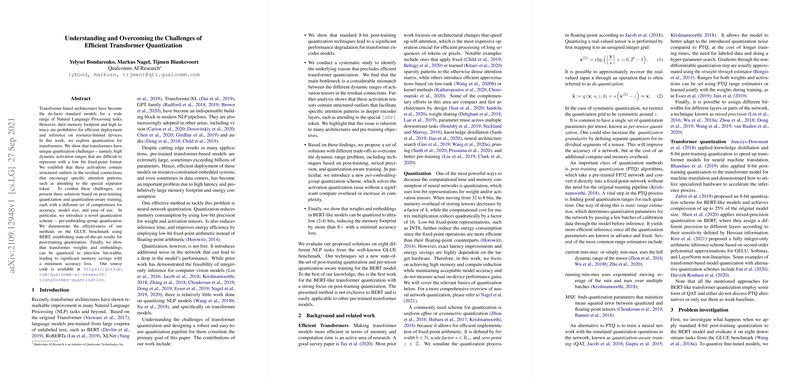Overview of Efficient Transformer Quantization Challenges and Solutions
The paper "Understanding and Overcoming the Challenges of Efficient Transformer Quantization" thoroughly investigates the challenges associated with quantizing transformer-based models, particularly focusing on architectures like BERT, which have become foundational in NLP tasks. The research highlights that, despite the critical role of these models in various applications, their high memory footprint and latency pose significant obstacles to efficient deployment, particularly on resource-limited devices.
Key Challenges in Transformer Quantization
The authors identified unique challenges in quantizing transformers, primarily due to the high dynamic range of activations, which complicates representation in low-bit fixed-point formats. A notable finding is the presence of structured outliers in the residual connections of these models, which can alter attention patterns, such as overemphasizing the special separator token. Such behavior is prevalent in deeper encoder layers, thereby impeding the prospects of straightforward quantization without severe performance degradation.
Contributions and Proposed Solutions
The paper introduces several technical solutions to mitigate these challenges. These include:
- Post-Training Quantization (PTQ) Limitations: Initial experiments revealed that standard 8-bit PTQ leads to marked performance drops, which were especially pronounced in the activation quantization process. The authors identified that this degradation stems from the residual sum after the FFN, where drastic dynamic range mismatches exacerbate quantization noise.
- Three-Pronged Solution Approach:
- Mixed Precision PTQ: This technique selectively allocates higher precision to sensitive parts of the network, such as using 16-bit activations for problematic layers while maintaining others at 8-bit to achieve a balance between accuracy and efficiency.
- Per-Embedding-Group Quantization: A novel approach that introduces quantization at the granularity of embedding groups. This strategy centralizes the quantization of particular embedding dimensions that generate outliers, thus preserving model accuracy without significant computational overhead.
- Quantization-Aware Training (QAT): By incorporating quantization steps into the training process, this method allows for adaptation to quantization noise, maintaining the accuracy of the models when deployed in low-bit configurations.
Experimental Validation
The research rigorously evaluates these methods on BERT models using the GLUE benchmark. The results set new state-of-the-art benchmarks for PTQ and QAT, significantly mitigating performance losses typically associated with such quantization methods. Notably, mixed precision and per-embedding-group quantization demonstrated impressive memory savings alongside negligible reductions in model accuracy.
Implications and Future Directions
The implications of this work are multifaceted. Practically, the demonstrated techniques make transformer models viable for deployment in memory and power-constrained environments, such as mobile devices and edge computing platforms. Theoretically, these findings challenge the prevailing assumptions in model quantization and open avenues for further exploration of fine-grained quantization methods that adapt specifically to neural architecture characteristics.
Future developments could explore adaptive quantization schemes, possibly leveraging dynamic quantization that adjusts bit-widths based on real-time computational constraints or task-specific demands. Additionally, integrating these quantization techniques within an automated machine learning pipeline could further generalize their applicability to various neural architectures beyond BERT-like transformers.
In conclusion, the findings and methodologies presented in this paper contribute significantly to the field of efficient model inference, providing robust techniques that balance performance and deployability in modern AI systems.
